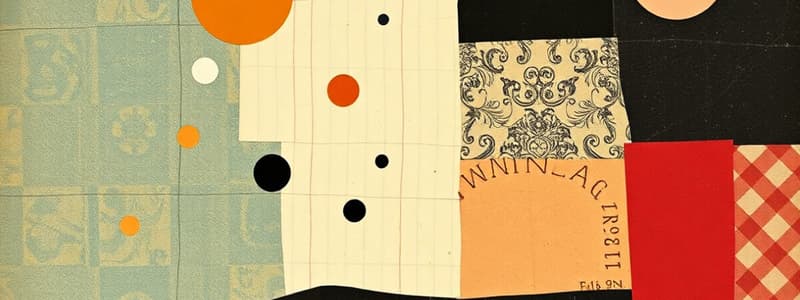Podcast
Questions and Answers
Quais de iste fibras es considerate como fibras staple?
Quais de iste fibras es considerate como fibras staple?
- Nylon
- Polyester
- Silk
- Cotton (correct)
Quais de iste caracteristicas es associate con fibra wool?
Quais de iste caracteristicas es associate con fibra wool?
- Resistential de abrasione alta
- Elasticidad alta
- Wicking moderate (correct)
- Fortia moderate (correct)
Quais de iste fibras es categoric como filament fiber?
Quais de iste fibras es categoric como filament fiber?
- Acrylic
- Cotton
- Wool
- Polyester (correct)
Qual fibra presenta la plus alta puntuazione in flammability?
Qual fibra presenta la plus alta puntuazione in flammability?
Qual fibra ha la plus baixa puntuazione in creasing resistance?
Qual fibra ha la plus baixa puntuazione in creasing resistance?
Qual caracteristica de fibra ha un impacte direct sur le precio?
Qual caracteristica de fibra ha un impacte direct sur le precio?
Quais de iste fibras es nota pro su alta resistentia contra plagas?
Quais de iste fibras es nota pro su alta resistentia contra plagas?
Quai de iste fibras ha la plus alta puntuazione in elasticity?
Quai de iste fibras ha la plus alta puntuazione in elasticity?
Quali de le sequente es un fibra natural?
Quali de le sequente es un fibra natural?
Qual fiber es classify como un fibra sintetica?
Qual fiber es classify como un fibra sintetica?
Le qual fibra es un exemplo de fibra cellulosica?
Le qual fibra es un exemplo de fibra cellulosica?
Le qual grupa tracta de fibras mineral?
Le qual grupa tracta de fibras mineral?
Qual statement es ver contra le classification de fibras?
Qual statement es ver contra le classification de fibras?
Qual es un exemplo de fibra animal?
Qual es un exemplo de fibra animal?
Qual de le sequente non es un fibra man-made?
Qual de le sequente non es un fibra man-made?
Le qual fibra es classify como un fibra regenerate?
Le qual fibra es classify como un fibra regenerate?
Qual es le valore tottenete qui? (0 - Poor; 2 - Generally Acceptable; 4 - Very Good)
Qual es le valore tottenete qui? (0 - Poor; 2 - Generally Acceptable; 4 - Very Good)
Qual materia ha un valore aesthetic in le describite section?
Qual materia ha un valore aesthetic in le describite section?
Le qualitas aesthetic es describe como 'Generally Acceptable', qual valore corrisponde a isto?
Le qualitas aesthetic es describe como 'Generally Acceptable', qual valore corrisponde a isto?
Qual de le sequente materiales non es mentionate in le content?
Qual de le sequente materiales non es mentionate in le content?
Le qual es le maximum valor tottenete in le systema de evaluo?
Le qual es le maximum valor tottenete in le systema de evaluo?
Qual es le expression correcte pro 'Poor' in le sistema de evaluo?
Qual es le expression correcte pro 'Poor' in le sistema de evaluo?
Qual es le categoria de 'Flax' mentionate in le content?
Qual es le categoria de 'Flax' mentionate in le content?
In le context de apparente aesthetic, qual es un factor non mentionate?
In le context de apparente aesthetic, qual es un factor non mentionate?
Flashcards
Natural Fibers
Natural Fibers
Fibers of biological origin, derived from plants, animals, or minerals.
Vegetable Fibers
Vegetable Fibers
Natural fibers derived from plants, like cotton, jute, and linen.
Animal Fibers
Animal Fibers
Natural fibers of animal origin, such as wool and silk.
Mineral Fibers
Mineral Fibers
Signup and view all the flashcards
Man-Made Fibers
Man-Made Fibers
Signup and view all the flashcards
Regenerated Fibers
Regenerated Fibers
Signup and view all the flashcards
Synthetic Fibers
Synthetic Fibers
Signup and view all the flashcards
Cellulosic Fibers
Cellulosic Fibers
Signup and view all the flashcards
Aesthetic Apparance
Aesthetic Apparance
Signup and view all the flashcards
Grand Total
Grand Total
Signup and view all the flashcards
Cotton
Cotton
Signup and view all the flashcards
Session
Session
Signup and view all the flashcards
Linen
Linen
Signup and view all the flashcards
Flax
Flax
Signup and view all the flashcards
0 - Poor
0 - Poor
Signup and view all the flashcards
4 - Very Good
4 - Very Good
Signup and view all the flashcards
Staple Fiber
Staple Fiber
Signup and view all the flashcards
Filament Fiber
Filament Fiber
Signup and view all the flashcards
Silk
Silk
Signup and view all the flashcards
Polyester
Polyester
Signup and view all the flashcards
Nylon
Nylon
Signup and view all the flashcards
Fiber Properties
Fiber Properties
Signup and view all the flashcards
Study Notes
Fabric Knowledge for Merchandisers
- Fabric knowledge is crucial for fashion management professionals.
- A fiber is the smallest part of a fabric, a fine, hair-like substance.
- Fibers have a high length-to-width ratio, enabling flexibility during manufacturing and use.
- Fibers are grouped and twisted into continuous strands called yarns.
Classification of Fibers
- Fibers can be categorized as natural or man-made.
- Natural fibers are further classified as vegetable, animal, and mineral.
- Vegetable fibers include cotton, jute, and linen.
- Animal fibers include wool and silk.
- Mineral fibers include asbestos and glass.
- Man-made fibers are further categorized as regenerated fibers (like viscose and acetate) and synthetic fibers (like polyester and nylon).
- Fibers can also be classified as staple or filament fibers.
- Staple fibers are short fibers (like cotton).
- Filament fibers are long fibers (like silk and nylon).
Cotton
- Cotton is used for various garments like jeans, t-shirts, and towels.
- It is cool to wear, soft, drapes well, and is durable.
- It is washable and ironable but creases easily.
- It is very absorbent and dries slowly.
- Advantages: cool to wear, very absorbent, soft handle, good drape, durable, completely washable and dry-cleanable, no static or pilling problems, inexpensive.
- Disadvantages: wrinkles easily unless treated, susceptible to mildew and strong acids, poor elasticity and resiliency, less luster.
- Cotton is hypoallergenic as it doesn't irritate sensitive skin or cause allergies.
- Cotton's softness makes it a preferred fabric for underwear and other garments that touch the skin.
- Cotton is a popular choice for fashion and homeware designers due to its easy dyeing capabilities.
- Durable press is a finishing treatment for cotton, eliminating creasing and ironing needs.
Linen
- Linen is textile fibers from the flax plant.
- Linen production is labor-intensive.
- Advantages: Best wicking (therefore cool to wear), dries quickly, natural soft sheen, strong and durable, does not melt.
- Disadvantages: Wrinkles badly unless treated, susceptible to mildew and strong acids, color frosts on creases, may be weakened with repeated creasing, may scorch.
- Linen is the strongest of the vegetable fibers.
- It becomes softer with repeated washing.
- Linen fabrics have high natural luster.
- Linen can withstand high temperatures and has moderate shrinkage.
- Linen is easier to iron when damp.
- Uses of linen include high-street fashion skirts, ladies tops, sweaters, formal wear, chef uniforms, aprons, school uniforms, and medical uniforms.
- Priests often prefer linen due to its purity.
Studying That Suits You
Use AI to generate personalized quizzes and flashcards to suit your learning preferences.




